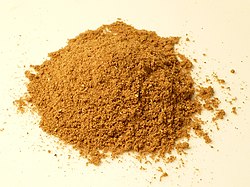Garam masala

Garam masala (Hindi: गरम मसाला, Template:Lang-pnb,Template:Lang-ur garam ("hot") and masala (a mixture of spices)) is a blend of ground spices common in North India , Pakistan, and other South Asian cuisines.[1] It is used alone or with other seasonings. The word garam refers to "heat" in the Ayurvedic sense of the word, meaning "to heat the body" as these spices, in the Ayurvedic system of medicine, elevate body temperature.
Ingredients

The composition of garam masala differs regionally, with many recipes across India according to regional and personal taste,[1] and none is considered more authentic than others. The components of the mix are toasted, then ground together.
A typical Indian version of garam masala contains:
- Black and white peppercorns
- Cloves
- Cinnamon or cassia bark
- Mace (Nutmeg)
- Black and green cardamom pods
- Bay leaf
- Cumin
Some recipes[2] call for the spices to be blended with herbs, while others call for the spices to be ground with water, vinegar, coconut milk, or other liquids, to make a paste. In some recipes, ingredients including nuts, onions, or garlic may be added. Some recipes also call for small quantities of star anise, asafoetida, chili, stone flower (known as dagadphool), and kababchini (cubeb). The flavours may be carefully blended to achieve a balanced effect, or a single flavour may be emphasized. A masala may be toasted before use to release its flavours and aromas.[1]
Use in specific dishes
This section needs additional citations for verification. (August 2013) |
The order in which spices are added to food may be very elaborate in some dishes. These include:
- Rogan josh: In the case of this Kashmiri speciality, for example, coriander, ginger and chilies are each ground individually, and a garam masala of cloves, cardamom, fennel, red or black chilies, cumin, turmeric and nutmeg, is prepared separately. The cook tastes the dish carefully to determine the precise moment when the next spice should be added. The order is coriander first, then the ground ginger, then the garam masala, and finally the chilies.[1]
- Murgh kari (chicken curry): In this chicken dish, the procedure is also precise. First, the chicken is fried and removed from the pan. Onion, garlic, and fresh ginger are added to the pan and cooked slowly for 7 to 8 minutes. The next procedure is where the cumin, turmeric, ground coriander, cayenne, and fennel seeds are added with water and fried for a minute or so. The third procedure involves the addition of tomato concassé with fresh coriander, yoghurt, and salt. The chicken is returned to the pan and more water is added. Finally, some garam masala is sprinkled on top, the pot is tightly covered, and the dish cooks another 20 minutes before serving.
- Pulao (Pilaf): In Pakistan, garam masala is a common additive to various types of this dish. It is usually added to hot oil, where the onions have been fried golden brown.
See also
- Baharat
- Bangladeshi cuisine
- Chaat masala
- Curry powder
- Indian cuisine
- Nepalese cuisine
- Pakistani cuisine
- Spice mix
References
- ^ a b c d Rama Rau, Santha (June 1969). The Cooking of India (Foods of the World). USA: Time Life Education. ISBN 978-0-8094-0069-0.
- ^ Bhide, Monica Garam Masala: A Taste Worth Acquiring npr.org April 27, 2011
External links
- Another garam masala recipe
- Punjabi garam masala recipe - learn to make Punjabi garam masala at home
